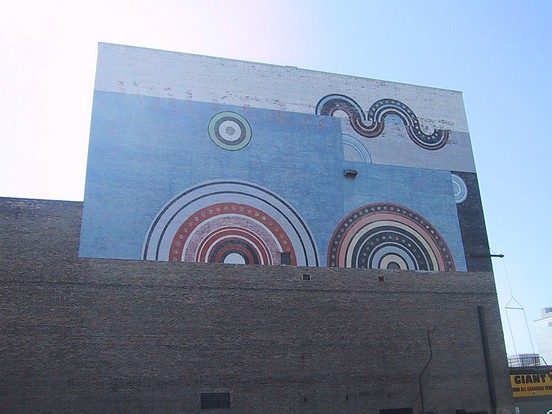|
|
|
|
|
|
Atb.jpg)




|
|
364 Smith Street
Location Map

This 1972 Mural still adorns part of the North wall of the Burton Cummings Theatre today; and is a good example of the strong graphic designs of Manitoba artist Winston Leathers.
|
Location: SW corner Smith & Notre Dame; North Face (high)
Occupant: Burton Cummings Theatre
District: City Centre
Neighbourhood: Central Park
Artist(s): Winston Leathers (unsigned)
Year: 1972
|
|
|
Winston Leathers (1932-2004).
An artist whose career spanned half a century, Leathers was known as a painter, printmaker,
poet and art educator. Ever the innovator, Leathers employed various techniques and media in
his artmaking.
This Mural on the former Walker Theatre (now known as the Burton Cummings Theatre) is itself a
landmark on a Winnipeg landmark; and is one of Winnipeg's oldest Murals still existing today. It was
rendered at approximately the same time as his important Cosmic Variations series of the early
1970s; and a quick comparison will show that it is essentially a part of that series, though on a
much larger physical scale. The Mural was part of the "Artwalls" public art project at the time. It
was largely due to the success of the Cosmic Variations series that this Mural happened.
In 1957, Leathers went to Mexico, where he worked with the Mexican Archaeological Society
under Dr. Carmen Cook de Leonard. It was here that Leathers developed an interest in Zen
Philosophy; and later was influenced by The American painter Mark Tobey (who studied Zen in
Japan) and Alan Watts (a leader of the Zen movement in the U.S. in the 1960s), a source of influence to his artwork all of his life. In 1958 Leathers
re-enrolled at the University of Manitoba, graduating from the Manitoba Teachers' College as an
art educator in 1960. He would go on to pursue a forty-year-long career, teaching basic design
and printmaking first at the Industrial Design Department of the Winnipeg Technical Vocational
High School (1958-68) and then in the Environmental Studies Department in the Faculty of
Architecture at the University of Manitoba, where he taught from 1969 until his retirement as full
Professor in 1993.
Throughout his career, Leathers constantly experimented in his work with different techniques,
media and technologies. In the 1960s Leathers and fellow University of Manitoba School of Art
graduate John Kenneth Esler pioneered the collograph printmaking technique in Canada. From
various found materials affixed to a printing plate, Leathers produced embossed abstract prints
that possess a deep emotional intensity and textural richness.
Others have decribed Leathers as a gifted, dedicated, generous and influential teacher. A Senior Canada Council
Fellowship during 1967-68 took him to England, where he became fascinated with Chinese and
Japanese calligraphic art on display in the British Museum. Leathers became fascinated with the
ancient art of calligraphy; both by the high status it is accorded in Japanese culture, and by its
practice as a form of meditation. A number of his works incorporate calligraphic markings. They
reflect Leathers' abiding interest in the teachings of Zen philosophy, with its emphasis on being
fully present in the moment and discovering one's own inner nature.
The natural environment was a driving force in Leathers' abstraction. His exploration of the
abstract forms found in nature continued with The Hidden Landscape series. In the late 1980s
Leathers collaborated with his former student, photographer Wayne Foster, who used
macrophotography techniques to create Cibachrome prints from mineral elements and liquids
fused between glass plates. Leathers' fascination with light, colour and form and his quest toward
pure abstraction in his art are evident in The Hidden Landscape series.
In addition to his intensive teaching activities, throughout his career, Leathers maintained a
professional artistic practice. Thus, in addition to more than 30 solo shows, he has shown in
about 140 group exhibitions throughout Canada, the United States, Europe, Japan and the
Caribbean. His work is found in over 50 public and corporate collections in Canada and
elsewhere, including most of the major Canadian collecting institutions.
Source: University of Manitoba Gallery One One One (various articles)
With Thanks to Ken Segal
==
About the Walker Theatre:
The 2000-seat Walker opened in 1907 and was named for its owner, Corliss Powers Walker,
who brought in live theater, vaudeville, concerts, and silent films. The theater switched to
a movies-only format in 1945 and remained in operation until 1990. In 1991, it reopened
as a performing arts center and is an official Manitoba Provincial Heritage Site.
Originally the Walker was to be part of a much larger hotel, retail and office complex, a
plan that was never realized. For many years the Walker was operated by Odeon/Morton
theaters as a movies only house and the name on the theater was changed to Odeon.
Morton had offices in the building. Odeon/Morton's renovations included extending and
altering the layout of the box office area, remodelling the front facade and adding a new
marquee. A concession stand was added just inside the foyer. Other alterations included
lowering the auditorium ceiling to install air conditioning and the removal of the 2nd
balcony, the outline of where it had been still faintly visible in the plasterwork of the side
walls. The logo and artwork that Odeon had painted on the exterior brickwork, as well as
the neon lettering "Always the best" is still there, minus the Odeon name now.
After years of struggling, Burton Cummings, the lead singer of the rock group Guess Who,
has become the theater's new benefactor. Cummings will begin donating a portion of the
proceeds of his concerts at the Walker in order to pay down the theater's $1.8 million debt
and fund future renovations.
In exchange for his aid, the theater was renamed the Burton Cummings Theatre for the
Performing Arts after the singer who attended the former movie house as a child. The
board hopes Cummings' name will help bring in additional grants and donations.
|
|